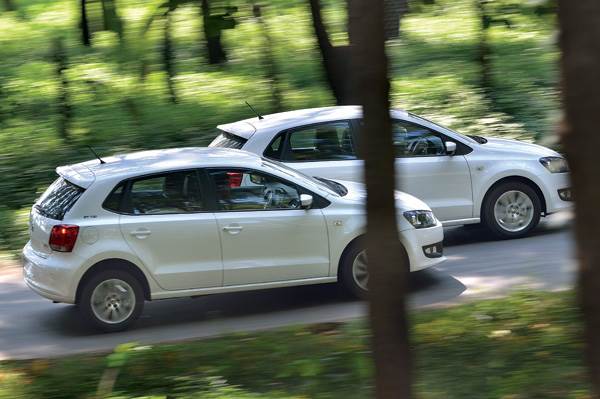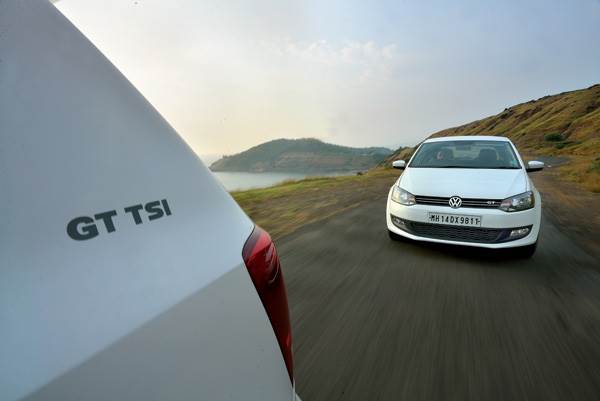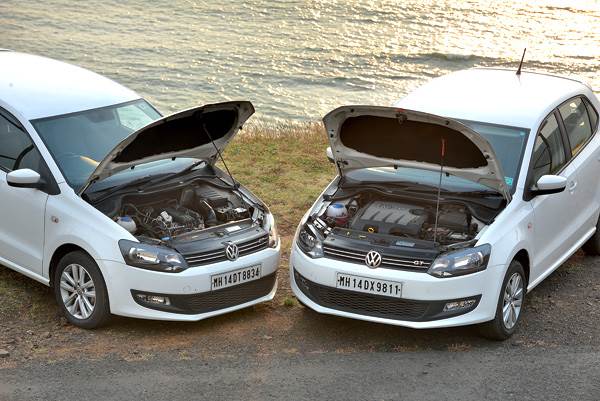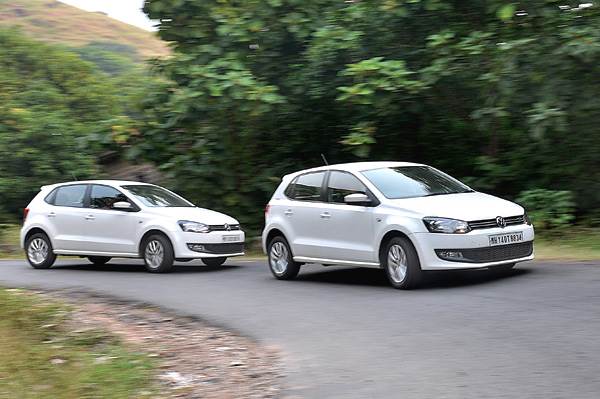New Volkswagen Polo GT TSI vs Polo GT TDI
With these new engines in the Polo, Volkswagen has found a good balance between power and comfort. We tell you which one is more fun.
Published On Dec 04, 2013 09:27:00 PM
4,52,774 Views
Follow us on



![]() By Staff Writer
By Staff Writer
This is a story of a car that’s always begged for more thrust. The three-cylinder petrol and diesel engines that the Polo made its Indian debut with were (and are) the weak links and never offered the smoothness and performance expected from a premium hatch.
That’s changed now with these new four-cylinder engines that make more power than what was available, and they bump up the Polo’s power-to-weight ratio from ho-hum to pulse-quickening. Meet the VW Polo GT TSI and the GT TDI. They are similar – Siamese twin looks, near-identical power outputs, Rs 1,000 apart on price and only available in Highline spec. But they take different bang-for-your-buck paths. The GT TSI has a lot of tech – direct-injection, turbo-charging, ESP and a twin-clutch automatic – while the GT TDI has the more conventional approach of common-rail diesel engine and a manual gearbox.
What we’re doing then is driving them through our favourite roads to see exactly how much fun they can be. Continued..
Heavy fuel
The diesel engine weighs 95kg while the TSI motor weighs 89.5kg, and this is expected. The diesel engine needs beefier internals to take the stresses of its much higher compression ratio – 16.5:1 as against 10:1 for the TSI – and this weight manifests itself in a lot of ways. We will come to that in a bit.
What the diesel has is a lot more torque, 25.5kgm of it. This doesn’t mean the TSI is a laggard – its 17.8kgm is a nice 2.2kgm more than you could ever get in a Polo (we’re talking about the now discontinued 1.6) and, on the whole, the GT TSI weighs less than the GT TDI as well.
The TSI also has a seven-speed auto, while the TDI has a five-speed manual and these are the only gearboxes they are available with. Despite this, in a straight line, it’s the TDI that noses ahead of the TSI by the time the cars cross 100kph. It’s 10.5sec for the TDI versus 10.9sec for the TSI. It’s an advantage that the diesel extends to over two seconds by the time the cars cross 150kph. There’s no replacement for displacement? Absolutely.
It’s the TSI that’s more exciting along the way though. Its 6200rpm redline (the TDI hits its limiter at 5000rpm) and the snarl it makes along the way are why it is so. The mid-range is particularly good and the TSI’s wider powerband encourages you to keep on pushing. The only thing you have to remember before you drive it enthusiastically is to slide the gearlever into manual mode and tap through the gears. In normal ‘D’, the gearbox seems extra keen to save fuel and won’t downshift unless you give it a bootfull of throttle.
The diesel is one we’re very familiar with. It is in the same spec as you get in the VW Vento, which means there’s a deliciously long, suitably punchy tug every time you push the throttle in. Because it is a relatively lag-free motor and despite the car weighing 16kg more than the Polo TSI, you can, within reason, leave it in any gear and it’ll pull forward cleanly. This is what makes it almost as easy to drive in traffic as the DSG-equipped TSI. You really don’t need to
keep shifting gears, and when you do need that burst of power, the diesel’s torque has enough reserve to push you ahead. That said, on loose surfaces, you get a bit of torque steer as all that power goes through the front seats.
The TSI needs a bit more attention in traffic. Unless you leave the transmission in ‘S’ or ‘M’, it takes time to downshift and that could leave you missing out on gaps in traffic.
Then, of course, there’s the fuel efficiency. TSIs are generally very sensitive to how much throttle you use – use it lightly and the engine can be very efficient. Push it hard though, and you’ll struggle to do more than 300km on a full tank. The diesel will easily cover a lot more ground on a tank even when you’re driving hard. Its 15.4kpl overall is quite a bit more than the petrol’s 13.2kpl. Continued..
Similar yet different
To compensate for the diesel engine’s weight, VW has had to give the GT TDI stiffer spring rates to prevent the nose from pitching uncomfortably. This extra weight also adds a bit more heft to the steering and makes for a car that doesn’t want to turn-in as easily into corners as its petrol brother. Mind you, these differences are minor and you really won’t notice them unless you drive the cars back to back.
What is obvious is how much lumpier the TDI’s ride is when you compare it to the TSI. On the bumpy back roads of Maharashtra, the diesel lets you feel a lot more of what state the road is in. Still, over undulating roads, the TDI feels tighter in the way it tackles mid-corner bumps and quick elevation changes.
The TSI, on the other hand, has a lot more slop in its body control. Over the same bit of undulating road, you need to drive the TSI in a manner that compensates for the extra movement that happens after hitting a bump. It does come with ESP though, and this is a bonus that the diesel does without. On the Mumbai-Pune expressway, the stiffer front springing of the TDI means it gets less upset by expansion joints, and this gives you the flatter, better poise that you’d want over longer distances.
From the soft rear suspension on both cars, it’s obvious that VW tried to find a good balance between comfort and handling and decided to lean towards the comfort end of the scale, which is a shame – both cars could do with a slightly sportier setup. What they also need are better brakes. By the way they feel on these cars, we assume VW didn’t bother upgrading the brakes from the lesser-powered Polos. The lack of initial bite is unnerving and it’s only when you push the pedal harder that the brakes start biting strongly. Continued..
One grouse
The GT TSI and GT TDI look identical to their lesser brethren. So, despite paying more, you get a car that is, save for a few GT TSI/TDI badges, indistinguishable from the rest of the range. They have the same specification of tyre, the alloy wheels are identical and there’s nothing that tells other car enthusiasts that you’re in one of the hot Polos. Then there’s the colour – VW offers the GTs in red, white or black. Come on, VW, variety is the spice of life, isn’t it?
Closely matched
Both cars are fun and it’s mostly down to their straightline performance that makes them so. Really keen drivers might not like them though. The TSI and TDI are a bit of a letdown when it comes to the finer points of driving – the steering is lifeless, body control is decent at best and it’s clear that power and comfort were the priorities for VW when these cars were thought up. Fair enough.
So, which one would we pick? Given that neither car is overtly sporty and that most owners will use them as everyday cars for relatively short distances, we would go the TSI way. Its combination of a smoother engine, more comfortable ride and a DSG gearbox that’s a decent compromise between the ease of use of an automatic and the involvement of a manual makes it the better everyday proposition. Sure, it may not be as quick as the diesel or as cheap to run. But because it is easy to use when you want it to be and quick enough when your mood demands it, it’s the one we would go with. Continued..
_04-12-2013.jpg&c=0&w=700)
Copyright (c) Autocar India. All rights reserved.


Comments
Member Login
Personal Details
No comments yet. Be the first to comment.